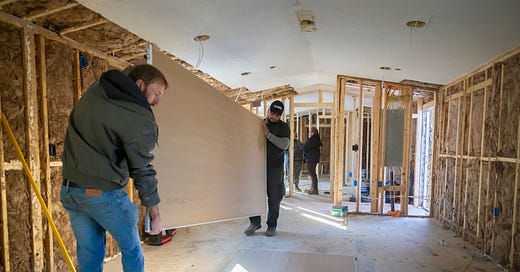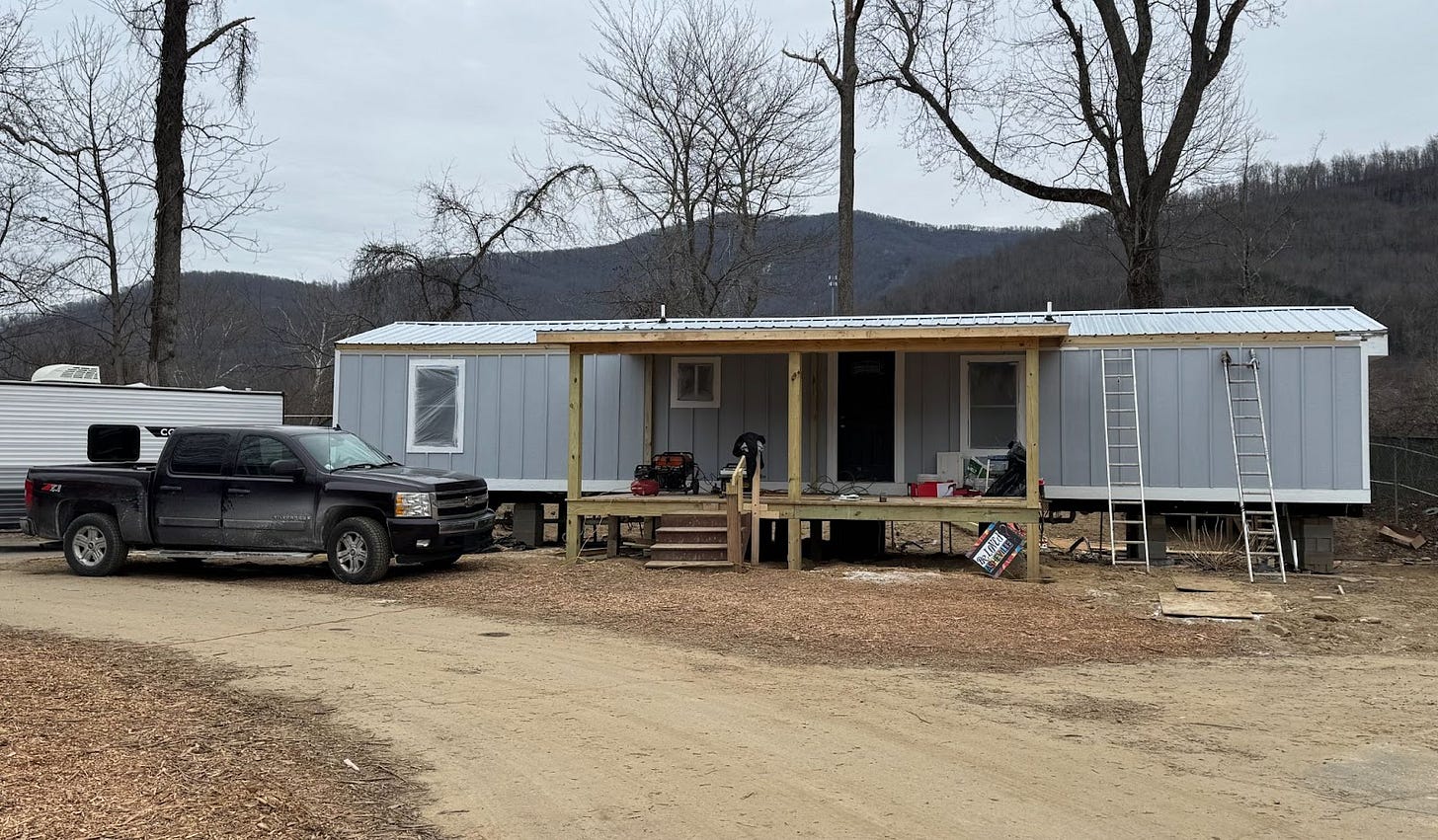In one mountain community, a crisis comes into focus
Flooding from Hurricane Helene devastated Swannanoa, displacing hundreds of families, but nonprofit and community efforts are helping rebuild homes and provide aid
The following article appeared in the Feb. 5, 2025, edition of The Charlotte Ledger, an e-newsletter with smart and original local news for Charlotte. We offer free and paid subscription plans. More info here.
LEDGER IN-DEPTH
Months after Hurricane Helene devastated Swannanoa, residents are still struggling with displacement, relying on nonprofits and community efforts to rebuild their homes and navigate housing uncertainty
International nonprofit CORE Response has been at the Alan Campos mobile home park in Swannanoa since October rebuilding the 30 mobile homes damaged by Hurricane Helene. (Photo courtesy of Liam Storrings/CORE)
by Lindsey Banks
Maria Salgado awoke Sept. 27 to the sound of firefighters banging on the door of their mobile home in Swannanoa, urging her family to evacuate.
She and other residents of the Alan Campos mobile home park had gone to bed the night before figuring the hurricane headed their way would just bring some rain. But when the Salgados rushed out of their home that morning, the water already reached their ankles. Within hours, the place would be unrecognizable.
While the floodwaters rose, Salgado and her family raced to help neighbors evacuate before running to safety up the hill to a relative’s house.
When Salgado and her husband waded back through chest-deep water later that day to retrieve their children’s Social Security cards and the title to their home, two feet of water covered the floors, and their furniture and belongings had floated from their original locations. The refrigerator was overturned, and food was scattered throughout the kitchen. Almost nothing was salvageable.
Four months later, Salgado and her family haven’t yet moved back, although they’ve continued to pay rent on their spot in the mobile home park. They’ve also been paying rent to Salgado’s brother, who’s been putting them up at his home nearby.
The Salgados are one of hundreds of families whose lives have been torn apart in Swannanoa, an unincorporated community of about 5,340 located 15 miles east of Asheville. Swannanoa has become known as the epicenter of the hurricane-induced housing crisis in Western North Carolina.
An estimated 340 homes were destroyed in Buncombe County, where Swannanoa is located, the Asheville Citizen Times reported. Those displaced have been making do in temporary situations, including hotels, camping trailers, tents, or staying with family and friends for the past four months.
More than 13,000 households across Western North Carolina, including some in Swannanoa, have used a Federal Emergency Management Agency program that pays for hotel or motel stays for people displaced by Helene. About 2,600 families, including 669 in Buncombe County, are currently using the program, a FEMA spokesperson told The Ledger.
Many displaced residents have also relied on help from nonprofits and startup community groups to rebuild their homes or find new ones. But local leaders doing that work say the rebuilding process is just beginning, and for many people, there’s still uncertainty about where they’ll wind up for good.
A nonprofit helps to rebuild
The Salgado family expects to move back into their home at the beginning of February, thanks to an international nonprofit called CORE, or Community Organized Relief Effort, which focuses on helping marginalized and immigrant communities during natural disasters who may not have as much access to FEMA assistance.
About a week after the hurricane, CORE arrived in Western North Carolina to distribute supplies and assess what the community needed most. A few weeks later, they got to work rebuilding all of the damaged homes in the Alan Campos mobile home park.
“We let the communities tell us what they need,” said Kirsty Greeno, a CORE staff member.
Alan Campos sits at the bottom of a hill and backs up against two lakes at the KOA campground and the Swannanoa River. When the river and lake water started rising, the neighborhood flooded, and the hill trapped the water. The homes at the bottom of the hill sustained the most damage.
Greeno arrived in Swannanoa on Oct. 13 to begin construction on about 30 homes that were damaged at Alan Campos, which houses about 125 trailers. Most of the residents own their trailers but rent the land from the park’s owner.
International nonprofit CORE Response is rebuilding 30 homes at Alan Campos mobile home park in Swannanoa. The neighborhood, which backs up to the Swannanoa River and two lakes on the KOA campground, was underwater on Sept. 27.
Churches and nonprofits across the country have donated new cabinets, flooring, HVAC systems and siding for the homes, and they’re being raised several feet to prevent damage from future storms. Residents pay for their new plumbing, but the rest of the rebuilding work is free to them, Greeno said.
Hurricane Helene was Greeno’s 14th natural disaster deployment. Although she’s seen this level of devastation before, she said the landslides made Western North Carolina different.
“The missing bodies and destruction from the landslides — that was a little different for me to see,” she said. “I was in Fort Myers (Fla.) after Hurricane Ian. I was in Texas after Harvey, so I’ve seen destruction on a wide scale. … It’s fairly on par with what I’ve seen before.”
CORE plans to stay in Swannanoa until all of the damaged homes in the Alan Campos mobile home community are repaired, which Greeno estimates will be through the spring. As of late last month, one resident had moved back in, with a few more, like the Salgado family, set to return within the next few weeks.
As people begin rebuilding their homes, Greeno said donations of furniture, appliances and building materials will be needed.
“The rebuild will take years and years,” Greeno said.
Residents launch a community effort
On Sept. 27, about 5 miles away from the Salgados’ home in the Alan Campos community, Swannanoa resident Beth Trigg invited neighbors who lived lower on the mountainside near the Swannanoa River to stay with her as a precaution.
Trigg and the half-dozen people who had evacuated to her house watched the homes below — and the farm where Trigg used to work — get washed away by the floodwaters.
A couple of days after the storm, Beth Trigg’s sister, Mary Etheridge-Trigg, and her family joined them. While doing a welfare check at the Jasper Apartments down the road on U.S. 70, they noticed that the apartment community was working together and pooling their supplies.
“It was happening all over,” Etheridge-Trigg said. “People in neighborhoods were creating their own systems.”
Inspired by what they saw, the sisters organized Swannanoa Communities Together, a community initiative that serves as a resource hub for the west side of Swannanoa. As an unincorporated community, Swannanoa lacks a governing body of elected officials, so residents’ needs often go unheard, Etheridge-Trigg said.
The sisters started out by offering supplies and resources to people affected by flooding but soon noticed that many were desperate for temporary and long-term housing.
“We started realizing housing was going to be a crisis because folks were coming to get supplies and we were talking to people, and they didn’t have a place to live because they were renters and had lost their rental,” Etheridge-Trigg said.
Many people were also out of work and struggling to pay bills, she said.
Swannanoa Communities Together is expected to become a 501(c)(3) nonprofit in February and so far has received support from local nonprofits and grants, Etheridge-Trigg said. The group has rented a small building and provides food, supplies, financial assistance and help to secure housing. The organization has a staff member who helps people navigate FEMA assistance and paperwork.
Etheridge-Trigg and Trigg say they see firsthand the frustration from residents who are trying to navigate FEMA benefits and the Transitional Sheltering Assistance program. There’s been confusion around who’s eligible for the program, how long they are allowed to stay and which hotels are accepting vouchers, Etheridge-Trigg said. A FEMA spokesperson said 247 hotels are participating in the program in North Carolina, and the program also covers taxes and pet fees.
“These are not fancy hotels with all the luxuries,” Trigg added. “This is living in hotels for many months with no kitchen, and you’re lucky if you have a mini fridge. You’re expected to live there with your kids and your pets, and then you’re expected to hurry up and find another place.”
Affordable housing options are harder to come by after the storm.
“The stuff that existed that was affordable—a lot of it is now physically gone,” Etheridge-Trigg said.
Holding on to faith
For many displaced Swannanoa residents, it’s unclear how their housing story will end.
Some are frantically looking for a resolution, while others are simply looking for signs, like Carol McCollum, who lived on the side of U.S. 70 directly across the Swannanoa River from the Alan Campos community.
She and her son took refuge in a dump truck outside their mobile home during the flood and anxiously watched as the rising water carried away cars, picnic tables and other debris.
“It was like a parade,” McCollum said.
Their home of 28 years was destroyed, so McCollum, 78, and her 40-year-old son have been staying at a relative’s house since that day.
Carol McCollum’s mobile home, which she lived in for 28 years, is now a pile of debris on the side of U.S. 70 in Swannanoa. (Left photo from Google Maps)
Last month, McCollum sat in a car alongside the remains of her mobile home that had been leveled by an excavator two days prior.
“There’s my couch,” she said, as she pointed to a mangled heap of wood and maroon fabric. “And that used to be my dryer,” she said with an exasperated laugh, motioning to the twisted mangled drum that used to dry her clothes.
Despite losing all of her possessions, McCollum said she believes her faith got her through the flood and that God has placed her exactly where she’s supposed to be.
“God has provided me with everything I need,” she said.
As her eyes searched the pile for her belongings, a man named Aaron Tew appeared from behind the rubble. He was rummaging through the debris and pulling out pieces of metal to turn in for money.
Tew approached the car where McCollum was sitting with a reporter, and he and McCollum exchanged phone numbers. Tew asked McCollum if there was anything she would want from her home if he came across it, and she had two requests: a canning jar that held sentimental value and a machine used to make colloidal silver.
Tew retreated back to the rubble, and appeared a few minutes later, holding a purple glass canning jar that was still miraculously in one piece.
“We were meant to meet you today,” McCollum told Tew as he handed her the jar through the car window.
She grabbed his hand and prayed aloud, thanking God for crossing their paths.
Then she headed back to her relative’s house, saying she’d wait for guidance from God on what to do next.
Lindsey Banks, a native of Swannanoa, is a staff reporter with The Charlotte Ledger. Reach her at lindsey@cltledger.com.
Need to sign up for this e-newsletter? We offer a free version, as well as paid memberships for full access to all 4 of our local newsletters:
The Charlotte Ledger is a locally owned media company that delivers smart and essential news. We strive for fairness and accuracy and will correct all known errors. The content reflects the independent editorial judgment of The Charlotte Ledger. Any advertising, paid marketing or sponsored content will be clearly labeled.
◼️ About The Ledger • Our Team • Website
◼️ Newsletters • Podcast • Newcomer Guide • A Better You email series
◼️ Subscribe • Sponsor • Events Board • Merch Store • Manage Your Account
◼️ Follow us on Facebook, Instagram, X/Twitter, LinkedIn







